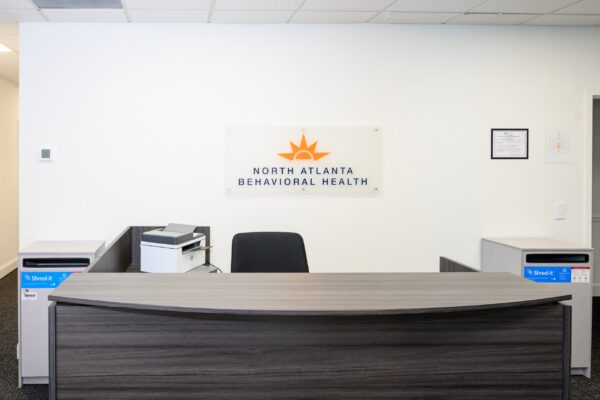Self-harm is often alarming not only to the person engaging in these behaviors but to loved ones as well. But there is hope to heal from the issues that cause self-harming behaviors. Self-harm treatment can help a person discover the underlying causes and find healthy ways to cope with extreme emotional distress.
North Atlanta Behavioral Health in Georgia offers treatment solutions for those engaging in self-harm. Our comprehensive treatment programs provide several avenues for treating the underlying issues that cause self-harm.
If you or a loved one is struggling with self-harm, call us today at 770-230-5699 or verify your insurance now.
What is Self-Harm?
Self-harm refers to a maladaptive behavior in which a person hurts themselves to feel temporary relief from psychological distress. This behavior is also called self-injurious behavior (SIB). Furthermore, self-harm can range from mild to severe.
Self-harm can be a symptom of a mental disorder, such as autism, post-traumatic stress disorder (PTSD), borderline personality disorder (BPD), anxiety, or depression.
Common examples of self-harm include the following behaviors:
- Cutting, scratching, or piercing the skin
- Pulling or ripping hair
- Burning oneself with matches, cigarettes, or heated objects
- Carving words or symbols into the skin
- Punching, biting, or pinching oneself
- Head banging
- Hitting a hard object or wall
- Swallowing inedible objects
- Inserting objects into the skin
- Picking at the skin and ripping scabs (to disrupt healing)
Usually, people self-injure their arms, legs, chest, and stomach. These are parts of the body that can be easily covered, thus hiding any marks or scars from self-harm. However, other body parts could be the target of self-harm.
It is also important to note that self-harm refers to non-suicidal self-injury. While self-harm could be deadly, the intent isn’t to end a person’s life like suicidal attempts and behaviors. In addition, people with eating disorders are at a high risk of engaging in self-harm.
Why Do People Self-Harm?
People self-harm when they feel emotional distress and don’t have other means of coping. These behaviors are a way of releasing pent-up tension and frustration. Self-harm can be a means of distraction from emotional pain, a way to feel a sense of control, a punishment inflicted on oneself, a way to feel something when a person feels numb or empty, or an expression of internal distress.
Furthermore, many people who self-harm have a low distress tolerance.
What is Distress Tolerance (And How Does It Relate to Self-Harm)?
Distress tolerance is a person’s ability to manage uncomfortable or stressful situations and feelings. People with a high tolerance for distress use healthy coping skills to regulate their emotions. However, those with a low distress tolerance often engage in maladaptive behaviors to regulate their emotions.
Self-harm is a maladaptive (unhealthy) way of coping with distress. Other maladaptive coping behaviors include substance abuse, gambling, aggression, and sex addiction. Thus, a person with a low distress tolerance is more likely to engage in self-harm and other maladaptive behaviors.
Is Self-Harm a Mental Disorder?
Self-harm is not a mental disorder, but it could be a symptom of a mental disorder. Nearly every mental disorder can lead to a person having a low distress tolerance. This could lead to self-harm or other maladaptive coping mechanisms.
Mental disorders associated with self-harm include the following:
- Borderline personality disorder (BPD)
- Anxiety disorders
- Depression
- Obsessive-compulsive disorder (OCD)
- Post-traumatic stress disorder (PTSD)
- Autism spectrum disorder (ASD)
In addition, veterans could be at a higher risk of self-harm than the general population. According to a study on Gulf War veterans published by the US Department of Veterans Affairs (VA), “Of the Veterans who responded, nearly 8% said they had engaged in nonsuicidal self-injury in the past year.”
Thus, self-harm treatment involves understanding the underlying causes of self-harm. Once a person understands why they engage in self-harm, they can find healthy coping skills to replace their maladaptive behaviors.
Anxiety and Self-Harm
Anxiety is a common reason people engage in self-harm. Oftentimes, anxiety results from an inability to regulate intense emotional reactions. Therefore, self-harm can be a way of distracting a person from intense anxiety or to regain a sense of control when they feel anxious.
Anxiety is also a common symptom of several mental disorders related to self-harm, such as borderline personality disorder, obsessive-compulsive disorder, and post-traumatic stress disorder.
Depression and Self-Harm
Like anxiety, depression is another mental health issue that can lead to self-harm. People with depression struggle with feeling empty or numb. While sadness is most often associated with depression, the reality is that most people with depression can’t feel any emotion—whether negative or positive.
So, in order to feel something, the person might engage in self-harm. The pain from self-harm is a maladaptive way of relieving the emotional emptiness that accompanies depression.

Signs and Symptoms of Self-Harm
Self-harming behaviors are generally misinterpreted as a way of getting attention from others. While this can be true sometimes, most of the time a person engaging in self-harm will hide their behaviors from others. This can make it difficult for others to notice the signs and symptoms of self-harm.
However, there are still ways to notice signs and symptoms of self-harm, including:
- Wearing long-sleeve shirts or pants during the summer to hide scars
- Frequently reporting accidental injuries to explain any scars or marks from self-harm
- Collecting knives or other sharp objects
- Fresh cuts, bite marks, scratches, or bruises appear more often than usual
- Scars that appear in patterns
- Difficulty regulating emotions and having intense reactions to stressful situations
- Low self-esteem
- Expressing feelings of hopelessness, helplessness, and despair
- Being easily frustrated and having a low distress tolerance
Since the person will usually try to hide or excuse any signs of self-harm, it can be difficult for loved ones to notice these signs. However, when patterns of some of the above-mentioned signs emerge and a person changes for the worse, they could be engaging in self-harm.
Self-harm treatment primarily focuses on two things: (1) preventing further incidents of self-harm and (2) treating the underlying cause of self-harm.
Preventing Self-Harm
Preventing self-harm involves replacing self-harming behaviors with healthy coping skills. Remember that a person engages in self-harm as a way of coping with emotional distress. Therefore, they need to find replacements to cope with distress.
Furthermore, the person also needs to find treatment for any underlying mental disorders or other psychological causes of self-harm. This will help a person build resiliency, self-esteem, and a healthy sense of mental well-being.
Some ways to prevent self-harm include the following:
- Reaching out for help. Sometimes, the first step is the most difficult. However, once a person admits that they are struggling, they can begin to work on improving their mental well-being.
- Trying alternative ways to relieve tension. Self-harming behaviors can lead to scarring or injury. But, other coping skills can have a similar effect without the risk of injury. These include things like holding a cube of ice, taking a cold shower, eating spicy or sour foods, or pinching a stress ball.
- Using healthy coping skills. Healthy coping skills can help a person replace maladaptive behaviors. Activities like journaling, listening to music, or meditating can help a person reduce stress without self-harm.
- Taking note of triggers. Triggers refer to anything that causes a person to engage in self-harm. A major aspect of self-harm treatment is to learn what triggers the intense emotions that lead to self-harm.
The above-mentioned activities can help to prevent self-harm by providing alternatives. Of course, professional treatment for the underlying causes of self-harming behaviors is a critical part of prevention.

Self-Harm Treatments
Self-harm treatment is really about treating the underlying causes of self-harming behaviors. Most often, the person has a mental disorder, and learning what disorder they have is the first step to treatment. In addition, treatment includes learning healthy coping skills for stress, low self-esteem, and other psychological issues.
If the cause of self-harm is a mental health disorder, North Atlanta Behavioral Health (NABH) is here with treatment programs that include the following:
- Individual, group, and family therapy
- Psychiatry
- Brainspotting and other trauma-based therapy
- Holistic approaches
Our outpatient programs involve individualized treatment plans that address all aspects of a person’s health and wellness. With evidence-based treatment, professional guidance, and peer support, our clients learn valuable means of coping with the underlying causes of self-harming behaviors.

By NABH Staff
Medically Reviewed by
Erika Dalton, LMSW.
Last Updated on March 18, 2024
Get Help Now
Begin Depression Treatment in Atlanta Today
Mental health disorders cannot be treated by treating the symptoms alone. We use holistic and evidence-based methods to treat the entire individual.
Facility Image Gallery
Get Help for Self-Harm Today
Self-harm is a sign of an underlying psychological issue or mental disorder. Thus, by treating the underlying causes of self-harm, a person can find healthy ways of coping with their symptoms. At North Atlanta Behavioral Health, we offer mental health treatment for those engaging in self-harming behaviors when the underlying cause is related to a mental health disorder.
Contact us today to begin self-harm treatment.

Treatment Philosophy
North Atlanta Behavioral Health is dedicated to the health and happiness of our clients. We offer personalized treatment plans that put each individual’s needs first.

Meet Our Team
Our multidisciplinary team wants nothing more than for our clients to achieve a lifetime of recovery and sobriety. Let us help you get the most out of treatment.
Additional Information
- Can I Go To Urgent Care of Anxiety and Depression?
- What is a 1013 in Georgia?













 I have been to my fair share of mental health programs and this one was extremely small, intimate and every staff member I have ever had contact with has been completely professional, compassionate, and caring.
I have been to my fair share of mental health programs and this one was extremely small, intimate and every staff member I have ever had contact with has been completely professional, compassionate, and caring.










